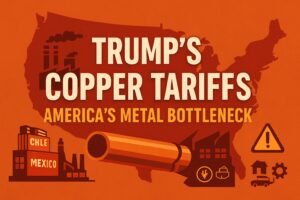On July 9, 2025, Donald Trump made a move that sent shockwaves through global markets. He announced a whopping 50% tariff on all copper imports, effective August 1. The result? Copper prices shot up like a rocket, mining stocks celebrated, and manufacturers everywhere started reaching for the antacids.
But here’s the thing: copper tariffs aren’t just another trade policy tweak. Copper is literally the backbone of modern life. It’s in your phone, your car, your house wiring, and pretty much everything that uses electricity. When you mess with copper, you’re messing with civilization itself.
So what exactly is Trump up to? And what does this mean for your wallet, America’s economy, and the rest of the world? Let’s break it down.
What’s Getting Hit by These Copper Tariffs?
Trump’s copper tariffs don’t just target raw copper ore sitting in the ground. They cover a whole buffet of copper products:
Raw Materials:
- Refined copper (cathodes, anodes, blister copper)
Semi-Finished Goods:
- Copper rods and wire bars
- Tubes and pipes
- Flat-rolled copper sheets
Think of these as the “ingredients” manufacturers use to make everything from Tesla batteries to the transformers that keep your lights on. And here’s the kicker: most U.S. manufacturers get their copper from these semi-finished imports because America simply doesn’t have enough processing plants.
It’s like having a great recipe but no kitchen to cook in.
The “National Security” Card: Real Threat or Political Theater?
Trump is playing the national security card here, using Section 232 — the same legal tool he used for steel and aluminum back in 2018. But there’s a plot twist: America doesn’t import most of its copper from enemies.
The biggest suppliers are actually allies:
- Chile
- Mexico
- Canada
- Peru
- Japan
So what’s the real game here?
Trump’s team argues that any dependency creates vulnerability. Even if your supplier is your best friend today, what happens when war, pandemic, or politics disrupt those supply lines? Suddenly, you’re scrambling to find copper for fighter jets and missile defense systems.
Plus, there’s the China factor. While China doesn’t directly supply much copper to the U.S., it dominates global copper refining and owns stakes in mines worldwide. That gives Beijing indirect influence over global copper markets — and Trump doesn’t like that one bit.
America’s Copper Paradox: Rich in Reserves, Poor in Processing
Here’s the ironic part: America has tons of copper in the ground. We’re talking about 48 million metric tons in reserves. That’s enough copper to wire a small planet.
But here’s where it gets frustrating:
The Numbers Don’t Add Up:
- U.S. copper demand: ~2 million metric tons per year
- Domestic mining: ~1.1 million tons
- U.S. refining capacity: Just 500,000-600,000 tons
See the problem? America can dig up copper, but it can’t process enough of it. Most U.S. copper concentrate gets shipped overseas for refining, then comes back as finished products. It’s like growing tomatoes, shipping them to Italy, and importing them back as pasta sauce.
The Real Issues:
- Underbuilt refining capacity
- Decades of moving production overseas
- A permitting process so slow you could retire before getting approval

Who’s Supplying America’s Copper Right Now?
Raw and Refined Copper:
- Chile (the copper kingdom)
- Mexico (our neighbor with benefits)
- Peru (mountain copper central)
- Canada (reliable as always)
- Japan (precision processing)
Semi-Finished Copper Products:
- Mexico (rods and wire)
- Vietnam (sheets and tubing)
- South Korea (battery foil)
- Germany (industrial-grade bars)
- China (lower-end products)
All of these suppliers are now staring down a 50% tariff wall. That’s going to hurt.

How These Copper Tariffs Will Hit Different Industries
Electrical and Electronics (43% of U.S. copper use)
Impact: Ouch.
This sector is getting hit hardest. Electric vehicles, transformers, circuit boards, and semiconductors all need copper like fish need water. Copper tariffs will drive up costs for everything from your smartphone to the power grid itself.
Construction (31% of copper use)
Impact: Expensive hammering ahead.
Copper tubing for plumbing, electrical wiring for smart homes, HVAC systems — all getting pricier. New home construction costs are about to get even more painful.
Transportation (13% of copper use)
Impact: EV sticker shock.
Electric vehicles use 2-4 times more copper than gas-powered cars. These copper tariffs could make EVs significantly more expensive, potentially slowing the green transition.
Industrial Equipment (8% of copper use)
Impact: Factory floor frustration.
Motor-based systems, factory robotics, industrial HVAC — expect cost escalation across the board.
Consumer Products (5% of copper use)
Impact: Manageable but noticeable.
Lower overall impact, but you might notice higher prices on electronics, appliances, and even fancy copper cookware.

Global Shockwaves from America’s Copper Tariffs
Trump’s announcement already rattled global markets. Copper prices jumped past $5.60 per pound, and mining stocks from Arizona to Peru shot up like fireworks.
But the longer-term effects could be massive:
Immediate Market Reactions:
- Copper-exporting countries scrambling to find new buyers
- Chinese refiners stepping in to fill supply gaps
- Global infrastructure projects facing cost inflation
Political Fallout:
- Allies feeling betrayed (especially Chile and Mexico)
- New diplomatic tensions over trade exemptions
- Potential retaliation against U.S. exports
Winners and Losers in the Copper Tariff Game
Winners (Breaking Out the Champagne)
- U.S. copper miners like Freeport-McMoRan and Southern Copper
- Political factions pushing for manufacturing renaissance
- North American refining startups (if they can scale fast enough)
Losers (Reaching for the Tissues)
- EV manufacturers and electrical infrastructure companies
- Housing developers and factory operators
- Copper-exporting allies caught in the crossfire
- American consumers facing higher prices
Can Trump’s Copper Tariffs Actually Work?
Trump has tried this playbook before. In 2018, he imposed tariffs on steel and aluminum using the same Section 232 national security provision. Critics predicted economic disaster.
The results were mixed but not catastrophic. Steel production did rise modestly, especially in the Midwest. Some dormant facilities came back online. But aluminum production struggled to gain traction, and downstream industries complained about higher costs and job losses.
But copper is different — and harder.
Unlike steel, which had idle mills ready to restart, copper has almost no spare domestic capacity. Most U.S. copper concentrate still gets exported for refining abroad, then re-imported as usable products.
Rebuilding copper capacity requires:
- Massive capital investment
- Faster permitting processes
- Cooperation across federal, state, and tribal jurisdictions
- Time — lots of time
Without these reforms, copper tariffs risk inflating costs more than building capacity. Unlike steel, there’s no dormant copper sector waiting to be restarted. It has to be built from scratch.
The Bottom Line: A High-Stakes Gamble
Trump’s 50% copper tariffs represent more than a trade policy shift. They’re a test case for how America handles critical materials in our new geopolitical reality.
This signals a move from free trade toward supply chain nationalism — from economic efficiency to strategic redundancy.
Whether this leads to a revival in American copper manufacturing or just higher costs for everyone depends on one crucial factor: Can the U.S. turn its vast copper reserves into real, usable industrial power?
Because without the ability to mine, refine, and shape its own metal, America might find itself holding the ore — but not the advantage.





